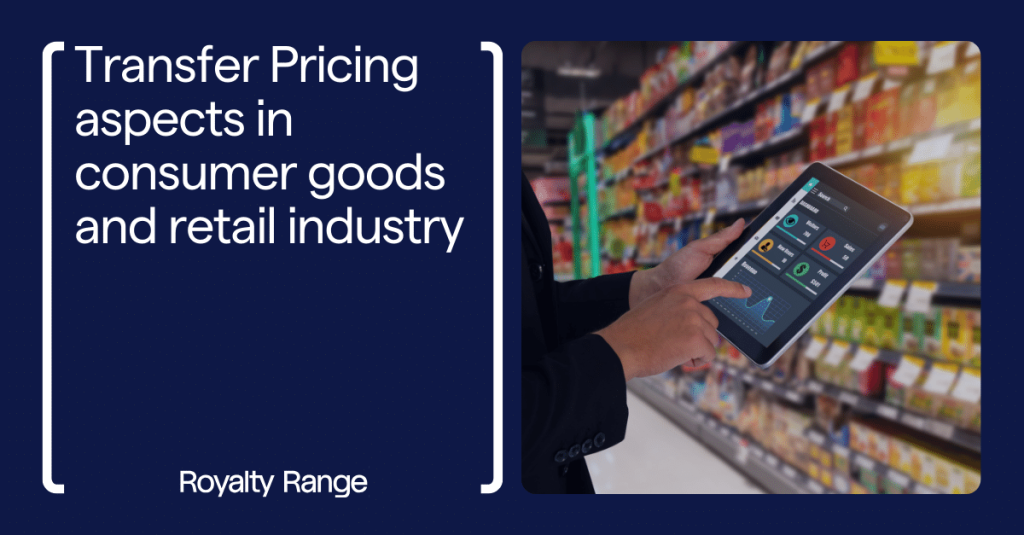Transfer Pricing aspects in consumer goods and retail industry
RoyaltyRange

The consumer goods and retail market has been undergoing several notable changes driven by shifts in consumer behavior, technological advancements, and global economic trends recently. Let‘s explore what should be taken into consideration when talking about Transfer Pricing in this sector.
The continued rise of e-commerce is reshaping the retail landscape, with consumers increasingly turning to online platforms for shopping convenience and safety, particularly during the COVID-19 pandemic. Traditional brick-and-mortar retailers are adapting by investing in omnichannel strategies to provide seamless shopping experiences across online and offline channels.
The widespread adoption of the internet and mobile devices has transformed how consumer product manufacturers and retailers conduct their operations. However, many of these companies are still using outdated Transfer Pricing systems that fail to account for this digital revolution. Neglecting to consider the impact of digital globalization can lead to tax audits across different countries, creating inconsistencies in how the same transactions are taxed. This can result in unexpected consequences such as tax assessments, penalties, and even double taxation. In simpler terms, not updating Transfer Pricing systems to reflect the digital landscape can cause problems with taxes in different places, leading to fines or being taxed twice for the same thing.
The changes brought about by digitalization have introduced a variety of complex issues for companies, including data management, data privacy, and international tax matters, on top of the challenges related to Transfer Pricing. With a significant portion of sales now happening online, it is often difficult to identify the exact location of a sale or even identify the purchaser accurately. This uncertainty poses a range of challenges when it comes to tax and Transfer Pricing, as it becomes unclear which jurisdictions should apply taxes and how profits should be allocated among different entities within the company. In simpler terms, the rise of online sales makes it tricky to determine where and to whom sales are happening, leading to complications in tax and Transfer Pricing arrangements.
Consumer product companies are always seeking ways to make their supply chains more efficient to stay ahead of the competition or even surpass it. Many of these companies have already put into action contemporary strategies to optimize their supply chains, like moving manufacturing operations offshore, establishing captive sourcing entities, and simplifying their logistics processes. In simpler terms, consumer product companies are constantly striving to make their supply chains work better, often by moving manufacturing overseas, creating their own sourcing companies, and making their logistics more straightforward. Changes in the supply chain can lead to a necessity to revisit and adjust a company‘s Transfer Pricing policies. At the same time, it is crucial to notice, that supply chain changes can come with indirect tax implications. When thinking about the supply chain, the interaction of Transfer Pricing with customs and duties, VAT, or other indirect taxes really should be carefully considered.
Nowadays data becomes a key value driver in the business. Effectively leveraging data involves ensuring that the insights derived from raw data are accessible at different stages of the supply chain, where they can be utilized with maximum efficiency. This point of view makes tax professionals acknowledge, that current tax system needs changes to work properly in digital economy. Significant role of technology in transforming the consumer goods and retail sector, with advancements in artificial intelligence, data analytics, and automation revolutionizing various aspects of the industry, from supply chain management to personalized marketing. Companies are leveraging data-driven insights to understand consumer preferences better, optimize inventory management, and deliver personalized shopping experiences.
Companies are widely using social media and this enables consumers to exchange experiences, enhance mutual support, and endorse products and services. Additionally, by analyzing data gathered from consumers’ interactions with a company’s website, the company can personalize its marketing efforts. This involves sending customized emails and other digital content to inform consumers about promotions or new product releases.
Although digital marketing offers significant advantages for brands, it also heightens the risk of brand mismanagement. This is due to the transparent, peer-to-peer nature of the medium, which makes it challenging for companies to control their brand messages effectively.
As companies in the consumer product industry enhance their utilization of data, the internet, and mobile apps, while also refining their sales channels, supply chains, and brand management, their tax departments need to evaluate how these advancements will impact current international tax and Transfer Pricing frameworks. With the rapid evolution of digital globalization, careful planning of the area is extremely important due to the potential widespread effects it can have.
Sources:
https://www2.deloitte.com/content/dam/Deloitte/us/Documents/Tax/us-tax-tp-industry-guide-2014.pdf
https://kpmg.com/us/en/podcasts/2023/industry-series-transfer-pricing-for-retail.html
https://en.tpcgroup-int.com/publications/transfer-pricing/transfer-pricing-in-industries/